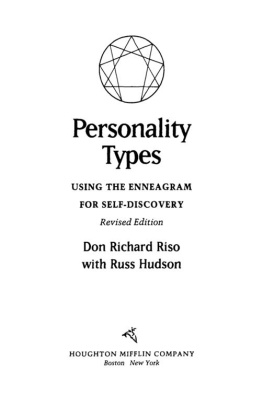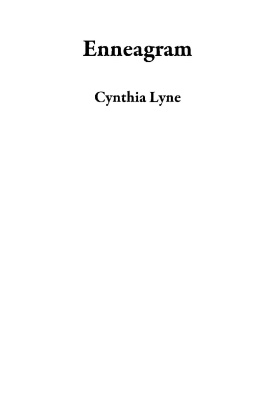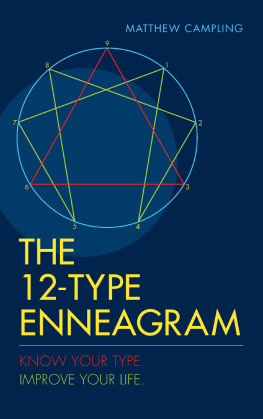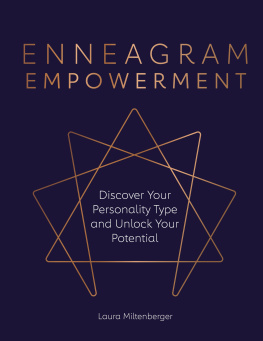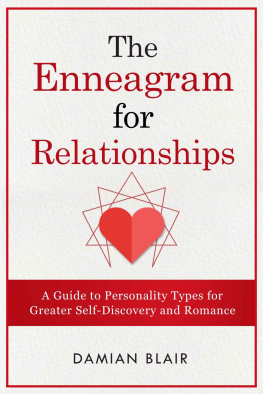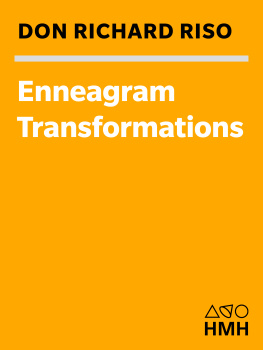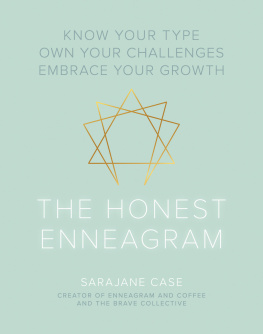Revised and Expanded
Houghton Mifflin Company
Boston New York 2003
F OR A N EW W ORLD
B ASED ON THE R EALIZATION
T HAT WE ARE O NE
Copyright 2003 by Don Richard Riso and Russ Hudson
All rights reserved
For information about permission to reproduce selections from this
book, including the Riso-Hudson Enneagram Type Indicator, write to
Permissions, Houghton Mifflin Company, 215 Park Avenue South,
New York, New York 10003.
Visit our Web site: www.houghtonmifflinbooks.com.
Library of Congress Cataloging-in-Publication Data
Riso, Don Richard
Discovering your personality type : the essential introduction
to the enneagram / Don Richard Riso and
Russ Hudson.Rev. and expanded.
p. cm.
Includes bibliographical references.
ISBN 0-618-21903-X
1. Riso Enneagram Type Indicator. 2. Enneagram. I.Hudson,
Russ. II. Title
BF698.8.R45R57 2003
155.2'6dc21 2002191289
The Enneagram of personality is a modern synthesis of ancient and
modern psychological and spiritual teachings. The contents of this
book are the result of the original work of the authors, and no body
of Enneagram material has been passed down in a pre-existing "oral
tradition" in the public domain. Please respect the rights of the
authors by not photocopying or otherwise infringing on this copy
righted material.
If you would like to obtain multiple copies of this book at a
discount, please contact the Special Sales Department at
617-351-5919.
Printed in the United States of America
Book design by Joyce C. Weston
QUM 10 9 8 7 6 5 4 3 2 1
Contents
Acknowledgments for the Revised and Expanded Edition
Part One
1. The Multi-Dimensional Enneagram
2. Instructions for the RHETI
3. The Riso-Hudson Enneagram Type Indicator
4. Scoring Instructions
Part Two
5. How the System Works
6. Type One: The Reformer
7. Type Two: The Helper
8. Type Three: The Achiever
9. Type Four: The Individualist
10. Type Five: The Investigator
11. Type Six: The Loyalist
12. Type Seven: The Enthusiast
13. Type Eight: The Challenger
14. Type Nine: The Peacemaker
Part Three
15. Interpretation: Getting More out of the RHETI
16. The Universal Ennegram: Applications in the Real World
Appendix: The Validation of the RHETI
Resources
Acknowledgments for the Revised and Expanded Edition
When we began writing about the Enneagram, one of our hopes was that publishing books about this wonderful subject would bring us into contact with wonderful people. That hope has come true, and we have been blessed not only with a life's work that seems to us to be worth doing but with extraordinary people with whom to do it.
We have, first of all, to thank those who have come to our Enneagram Workshops and Enneagram Professional Training Programs for their support and enthusiasm. They are spreading word of the Enneagram, quite literally, around the world. We also want to thank those who have encouraged us to develop a questionnaire. It was not something we were particularly interested in doing until we began to appreciate the usefulness of such an instrument. Thus, readers and students alike can perhaps take satisfaction in knowing that they have had an important role in bringing this project about.
Ruth Hapgood, senior editor at Houghton Mifflin, was a wise and steady presence during the years in which we worked together, including the period that saw the first edition of this book into print. We are indebted to her for her unflagging support of our work. Susan Canavan, our current editor, has been a helpful and enthusiastic supporter not only of our work but of the Enneagram. We are grateful to be working with her and look forward to other projects in the future.
Special thanks go to two of our students who are clinical psychologists, Quentin Dinardo, Ph.D., and Betsey Bittlingmaier, Ph.D., for their critique of the first version of this questionnaire. Arlen Baden and Claes Lilja were similarly helpful with comments, critiques, and many useful suggestions. Two other students, William Culp, Ph.D., and David Beswick, made valuable recommendations concerning the instructions for the RHETI that we are continuing to employ in this revised version. We are grateful to everyone who has helped improve the test, including the many students in our workshops and Trainings who so willingly served as "guinea pigs" during the years of its original conception and continued revision.
Walter Geldart, a brilliant Enneagram theoretician and student of ours, has been extremely encouraging and helpful with his comparisons of the RHETI with the MBTI. Walter has also led the way in introducing the Enneagram to the Myers-Briggs community. May his work continue to bear the fruit of cross-fertilization.
Rebecca Xiong has been of great assistance to us and to users of the RHETI by coding it for the Internet so that we could add it to our Web site. The ability to take the RHETI and to have it scored quickly online has enabled this test to be available to many more people, thereby also introducing them to the Enneagram and our work.
Rebecca Newgent, Ph.D. has been extremely helpful through her work in validating the RHETI scientifically. Dr. Newgent validated the RHETI as part of her doctoral work, and her findings have greatly boosted the confidence of those who needed some kind of statistical confirmation that the Enneagram worked and was worthwhile. Of course, we and hundreds of thousands of readers have always felt that intuitively, but it was gratifying to also have our faith confirmed by objective data. We look forward to working with Dr. Newgentand other qualified researcherson further validation studies of the RHETI and of other aspects of the Enneagram.
Just as we have thanked our students, we would like to again thank our teachers in the Diamond Approach, Hameed Ali, Alia Johnson, Rennie Moran, Morton Letofsky, Hammed Qabazard, Jeanne Hay, and Kristina Bear for their inspiration, guidance, and unwavering dedication to True Nature.
Russ: thanks to Catherine Chernick, David Fauvre, and Marika Dentai for encouraging me to look more deeply into the three instincts and their interaction with the Enneagram types. They generously shared their own curiosity in this topic which led me to study it more closely myself. I would also like to thank my family for their ongoing support and encouragement.
Don: I would like to offer heartfelt acknowledgment to my mother, Beverly Moreno Pumilia, and my father, Leo Riso. I thank them for all that they have given to me. The older I become, the more I realize how my best qualities are really theirs. Finally, my personal advisors, Brian Lawrence Taylor and Zack, are invaluable in more ways than I can say. Their commitment to my work has been deep and abiding, and without their constant support and guidance, doing it would have been impossible.
Last, we give thanks for the Guidance we have received as we continue to work on the Enneagram and attempt to live its lessons. As much as this work is the product of our own efforts, we can also truly say that it seems to come from something beyond us. There is a consciousness that wishes to manifest itself more clearly in the worldand we believe that the Enneagram is one important expression of this new consciousness. May all those who seek to awaken and know themselves find help with this remarkable tool.
Don Richard Riso and Russ Hudson
Stone Ridge, New York
June 2002
PART ONE
PLEASE NOTE:
If you wish to take the Riso-Hudson Enneagram Type Indicator right away, you can go to in this book now. It is not necessary to know anything about the Enneagram (pronounced "ANY-a-gram") to obtain valid results from this questionnaire.
Next page

